Maximizing Team Collaboration Through Effective Meeting Design

Introduction
In today's competitive business landscape, team collaboration plays a vital role in driving success. One essential aspect that contributes to effective teamwork is designing and conducting meetings that facilitate clear communication, creative problem-solving, and focused decision-making. However, many meetings tend to be unproductive, leaving participants feeling disengaged and frustrated.
The solution to unlocking your team's potential lies in mastering the art of effective meeting design. By carefully planning and structuring your meetings, you can create an environment that fosters collaboration, increases productivity, and helps your team achieve their objectives. In this article, we will delve into the critical components of effective meeting design and offer practical tips for maximizing team collaboration during your meetings. These insights will be beneficial for managers, supervisors, and team leads looking to improve their meeting planning skills and ensure seamless teamwork.
Essential Elements of Effective Meeting Design
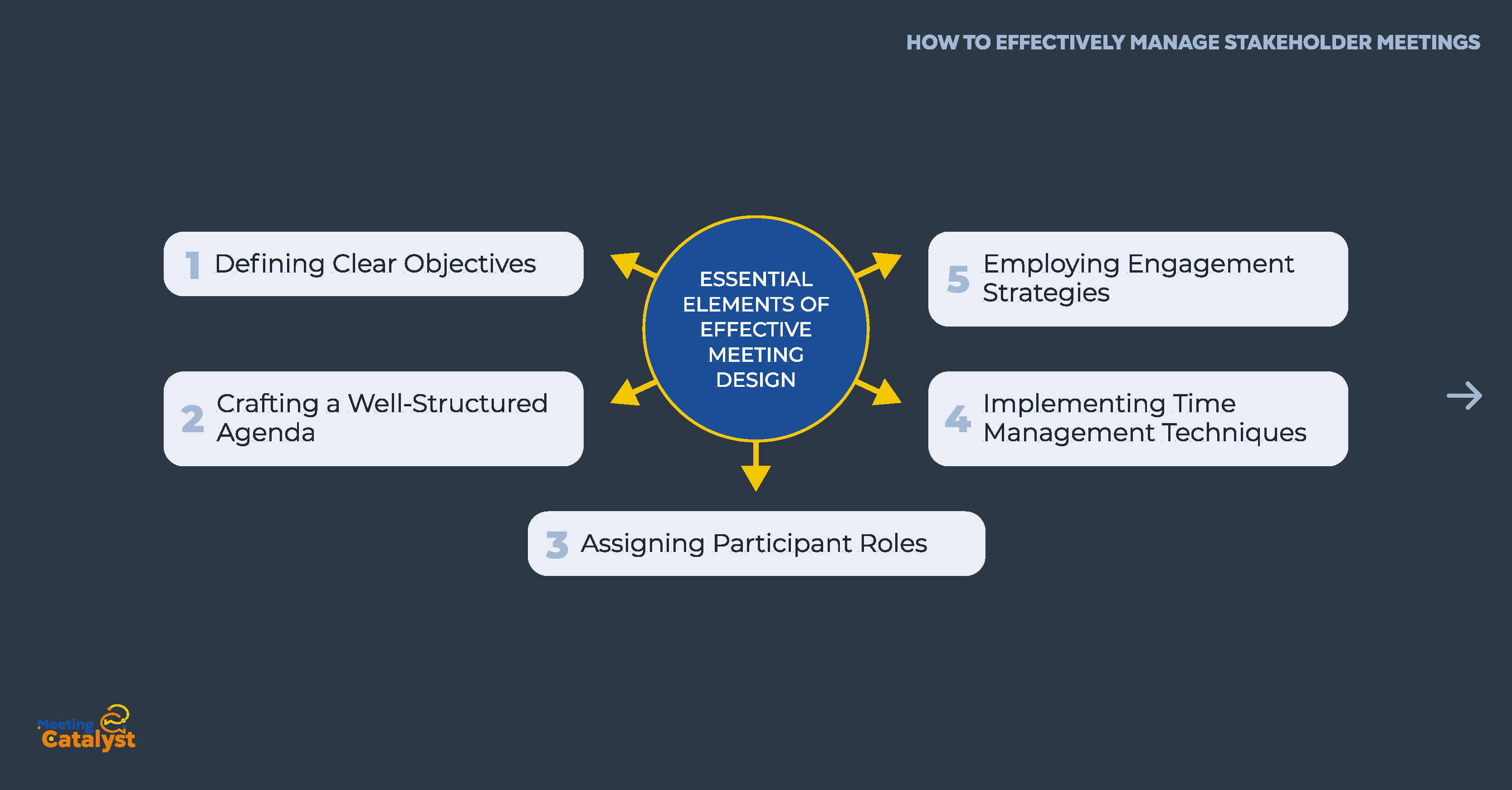
In order to maximize team collaboration and drive productivity, it's crucial to incorporate the key components of effective meeting design. Here are the essential elements to consider when designing your meetings:
1. Defining Clear Objectives
Establish clear objectives for your meetings to provide your team with direction and focus. Clearly outlining the purpose and desired outcomes helps participants understand the importance of the meeting and prepares them to contribute effectively.
- Use SMART (Specific, Measurable, Achievable, Relevant, Time-bound) criteria to set objectives.
- Communicate the objectives to participants in advance.
2. Crafting a Well-Structured Agenda
A well-structured agenda guides the meeting and ensures that all important topics are covered. This helps in keeping discussions on track and prevents wasted time.
- Outline the topics to be discussed and allocate appropriate time for each item.
- Prioritize agenda items based on importance and urgency.
- Distribute the agenda in advance to give team members time to prepare.
3. Assigning Participant Roles
Assigning specific roles to participants can improve meeting effectiveness and ensure that everyone is engaged. Examples of roles include the facilitator, timekeeper, and note-taker.
- Clearly define each role and its responsibilities.
- Rotate roles among team members to encourage involvement and develop skills.
4. Implementing Time Management Techniques
Effective time management is crucial for maintaining focus and ensuring that meetings are productive. Techniques such as timeboxing and setting time limits for agenda items can help keep meetings on track.
- Allocate time for each agenda item and stick to the schedule.
- Use a timer or timekeeper to monitor progress.
- Be prepared to adapt the schedule if needed, but ensure all critical items are addressed.
5. Employing Engagement Strategies
Keeping participants engaged is essential for fostering collaboration and generating valuable input. Utilize various engagement strategies to maintain interest and encourage active participation.
- Incorporate interactive elements, such as brainstorming sessions and group discussions.
- Use technology tools, like polling and collaboration platforms, to promote interaction.
- Encourage questions and feedback from participants throughout the meeting.
By incorporating these essential elements into your meeting design, you'll create an environment that fosters collaboration, increases productivity, and helps your team achieve their objectives.
Setting Clear Objectives for Enhanced Team Collaboration
The foundation of an effective meeting lies in setting clear objectives. Establishing well-defined goals not only guides the meeting process but also enhances team collaboration and helps your team achieve desired outcomes. In this section, we'll discuss the significance of setting clear objectives, how they contribute to team collaboration, and techniques for defining and communicating them.
The Significance of Establishing Clear Objectives in Meetings
Defining clear objectives is crucial for several reasons:
- It provides a roadmap for the meeting, ensuring that all discussions stay focused and relevant.
- It enables participants to understand the meeting's purpose and align their contributions accordingly.
- It sets expectations and establishes a benchmark for measuring meeting success.
By establishing clear objectives, you create a structured environment that fosters meaningful discussions and drives meeting goals.
How Clear Objectives Improve Team Collaboration
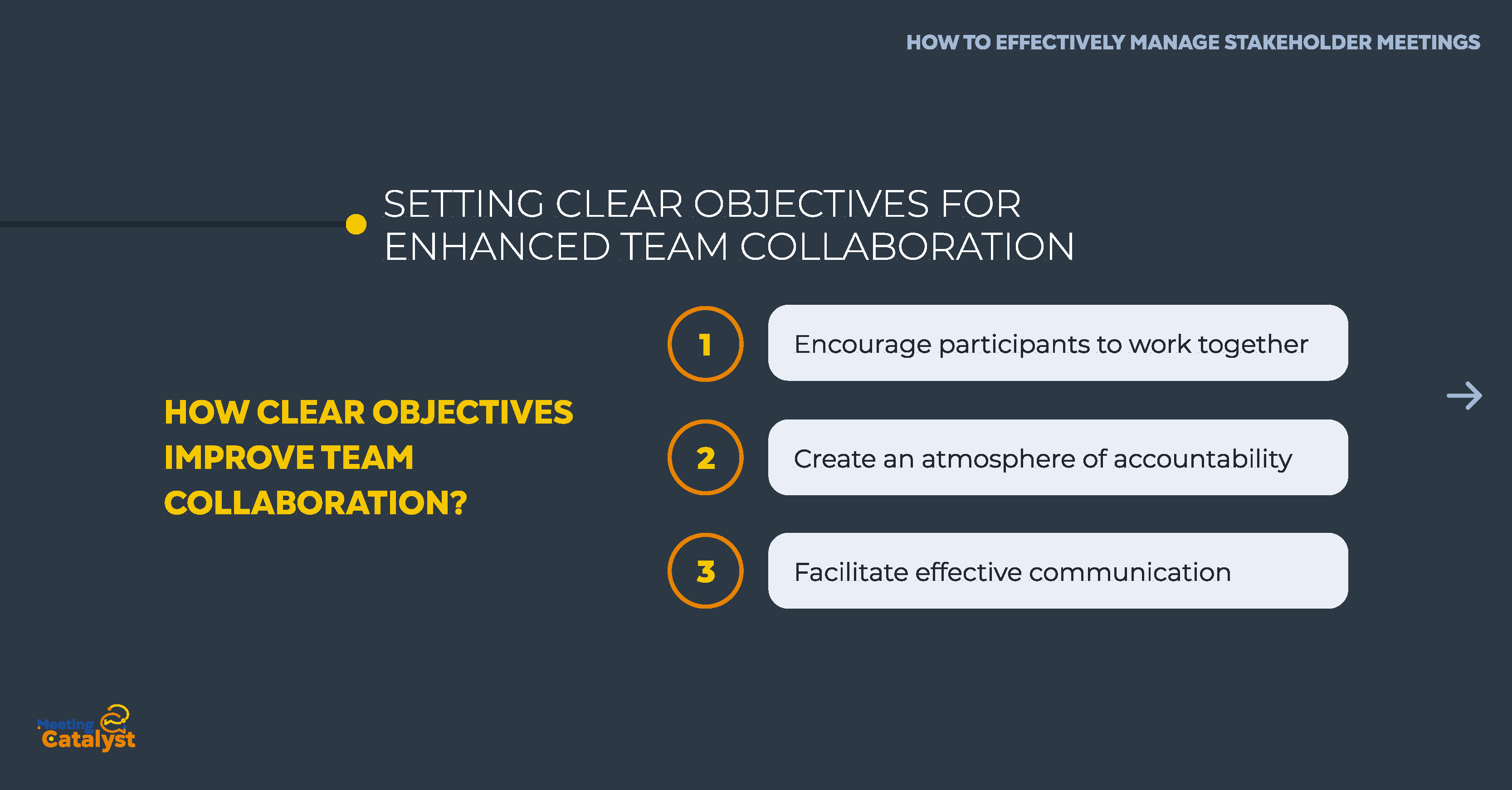
Clear objectives play a vital role in enhancing team collaboration during meetings:
- They encourage participants to work together towards a common goal, fostering a sense of unity and shared purpose.
- They create an atmosphere of accountability, motivating team members to actively contribute and take ownership of their roles.
- They facilitate effective communication by providing a framework for discussions, helping participants stay on the same page.
Incorporating clear objectives into your meeting design significantly improves team collaboration and overall meeting effectiveness.
Techniques for Setting and Communicating Clear Objectives
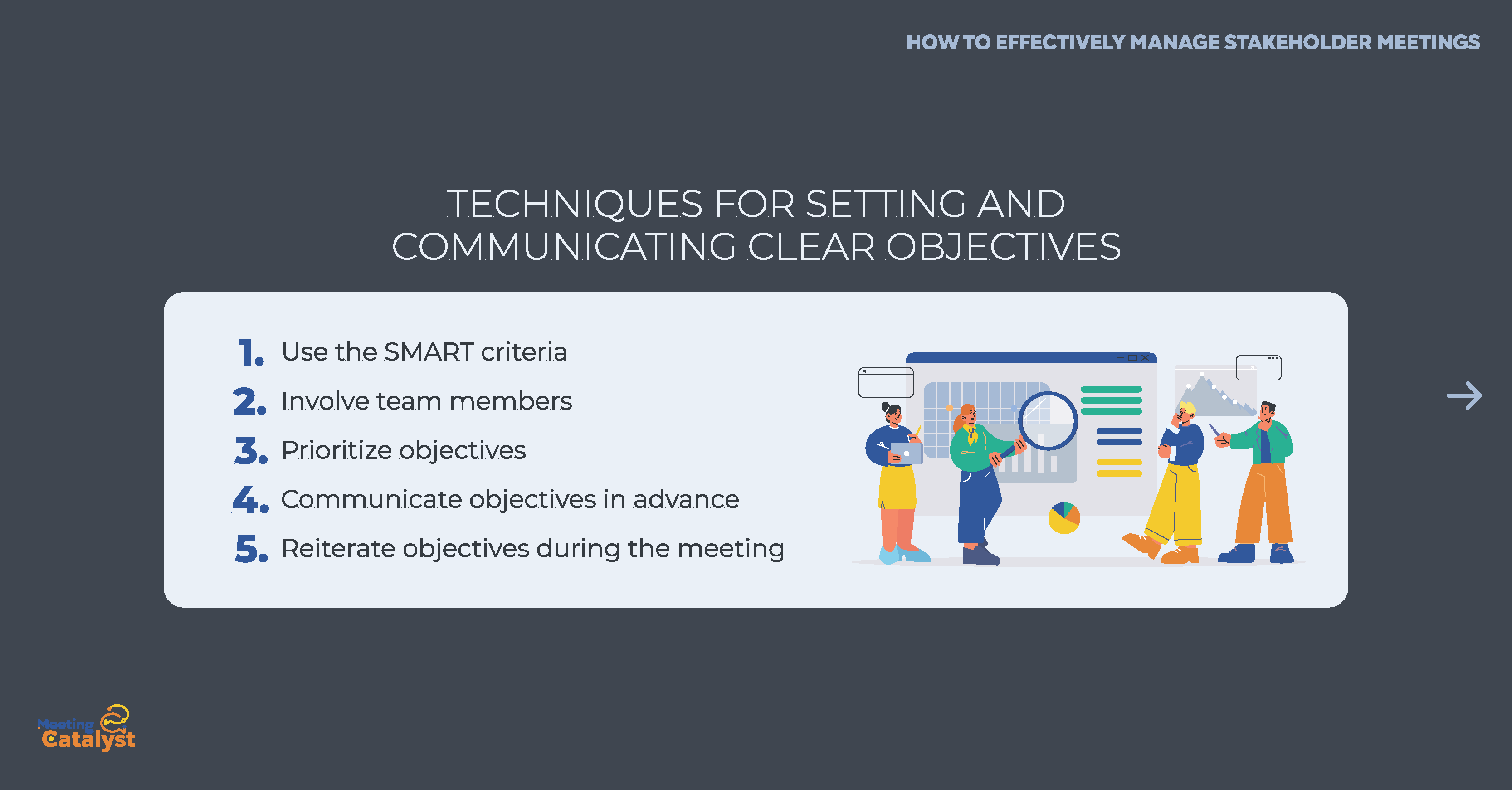
To set and communicate clear objectives, consider the following techniques:
Use the SMART criteria: Ensure your objectives are Specific, Measurable, Achievable, Relevant, and Time-bound. This framework helps create well-defined and actionable goals.
Involve team members: Encourage input from participants when setting objectives, as this promotes a sense of ownership and buy-in.
Prioritize objectives: Identify the most critical objectives and focus on them during the meeting, ensuring that important goals are addressed.
Communicate objectives in advance: Share the objectives with participants before the meeting, allowing them to come prepared and focused.
Reiterate objectives during the meeting: Remind participants of the objectives at the beginning of the meeting and as needed throughout, reinforcing their importance and keeping discussions on track.
By setting and communicating clear objectives for your meetings, you create an environment that fosters enhanced team collaboration and helps your team achieve their meeting goals.
Crafting a Well-Structured Agenda for Productive Meetings
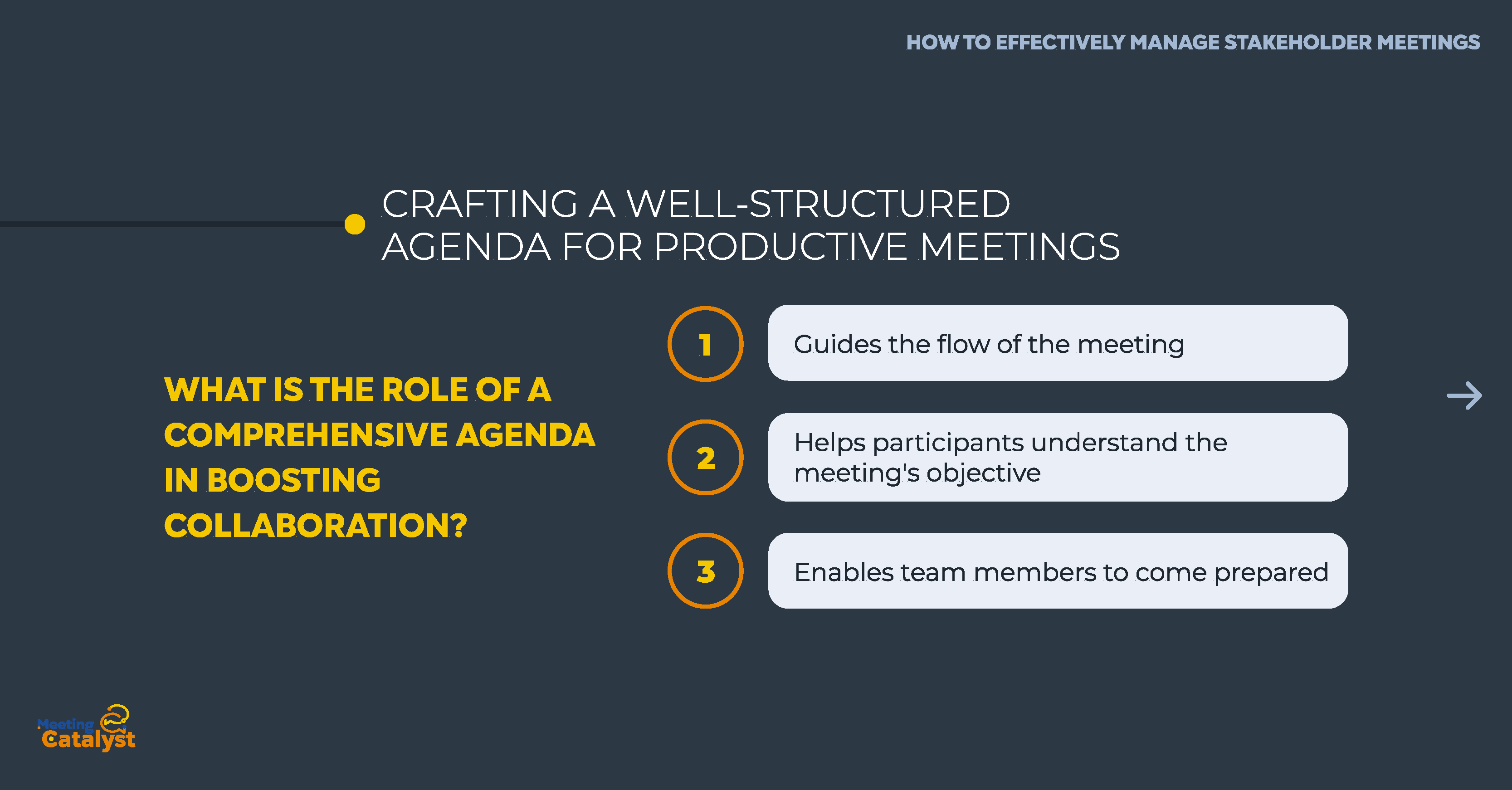
A well-structured agenda is instrumental in driving productive meetings and fostering teamwork. An effective agenda sets the stage for focused discussions, efficient use of time, and improved collaboration among team members. In this section, we'll explore the role of a comprehensive agenda in boosting collaboration and share tips for designing an agenda that encourages teamwork.
The Role of a Comprehensive Agenda in Boosting Collaboration
A well-crafted agenda serves as a roadmap for the meeting, offering numerous benefits:
- It guides the flow of the meeting, ensuring that all topics are covered systematically.
- It helps participants understand the meeting's objectives and the key topics they should focus on.
- It enables team members to come prepared, leading to more meaningful and informed discussions.
By incorporating a comprehensive agenda into your meeting design, you create a structured environment that promotes collaboration and drives meeting productivity.
Tips for Designing an Effective Agenda that Encourages Teamwork
To create an agenda that fosters teamwork and productivity, consider the following tips:
Prioritize topics based on importance: Arrange agenda items in order of priority, ensuring that crucial topics are addressed first. This approach helps maintain focus and maximize the value of the meeting.
Include breaks and team-building activities: Schedule breaks and incorporate team-building exercises into the agenda. This not only prevents burnout but also creates opportunities for team members to bond and strengthen their working relationships.
Encourage team members to contribute agenda items: Invite participants to suggest topics for discussion. This inclusive approach ensures that all team members feel heard and engaged, fostering a sense of ownership and commitment to the meeting outcomes.
By following these tips and designing a well-structured agenda, you create an environment that promotes teamwork and leads to more productive meetings. Implementing a comprehensive agenda is an essential step in maximizing team collaboration through effective meeting design.
Assigning Participant Roles for Increased Meeting Engagement
Assigning participant roles is crucial for boosting meeting engagement and fostering collaboration among team members. Clearly defined roles create a sense of ownership and responsibility, ensuring that all participants are actively involved in the meeting. In this section, we'll discuss the importance of defining participant roles in meetings, explore how assigning roles enhances collaboration and engagement, and delve into common meeting roles and their functions. We'll also examine the benefits of rotating meeting roles.
The Importance of Defining Participant Roles in Meetings
Defining participant roles is essential for several reasons:
- It helps participants understand their responsibilities and expectations during the meeting.
- It creates a structured environment that promotes accountability and engagement.
- It facilitates smoother meeting processes by distributing responsibilities among team members.
By assigning roles, you set the stage for a productive and collaborative meeting, where each participant contributes to the discussion.
How Assigning Roles Enhances Collaboration and Engagement
Assigning roles in meetings can lead to several benefits, such as:
- Improved focus on the discussion, as each participant is responsible for specific tasks.
- Increased sense of ownership and commitment, as team members understand their responsibilities.
- Enhanced collaboration, as participants actively contribute to the meeting and work together to achieve its objectives.
In short, assigning roles helps create a dynamic meeting environment where all team members are engaged and working together effectively.
Common Meeting Roles and Their Functions
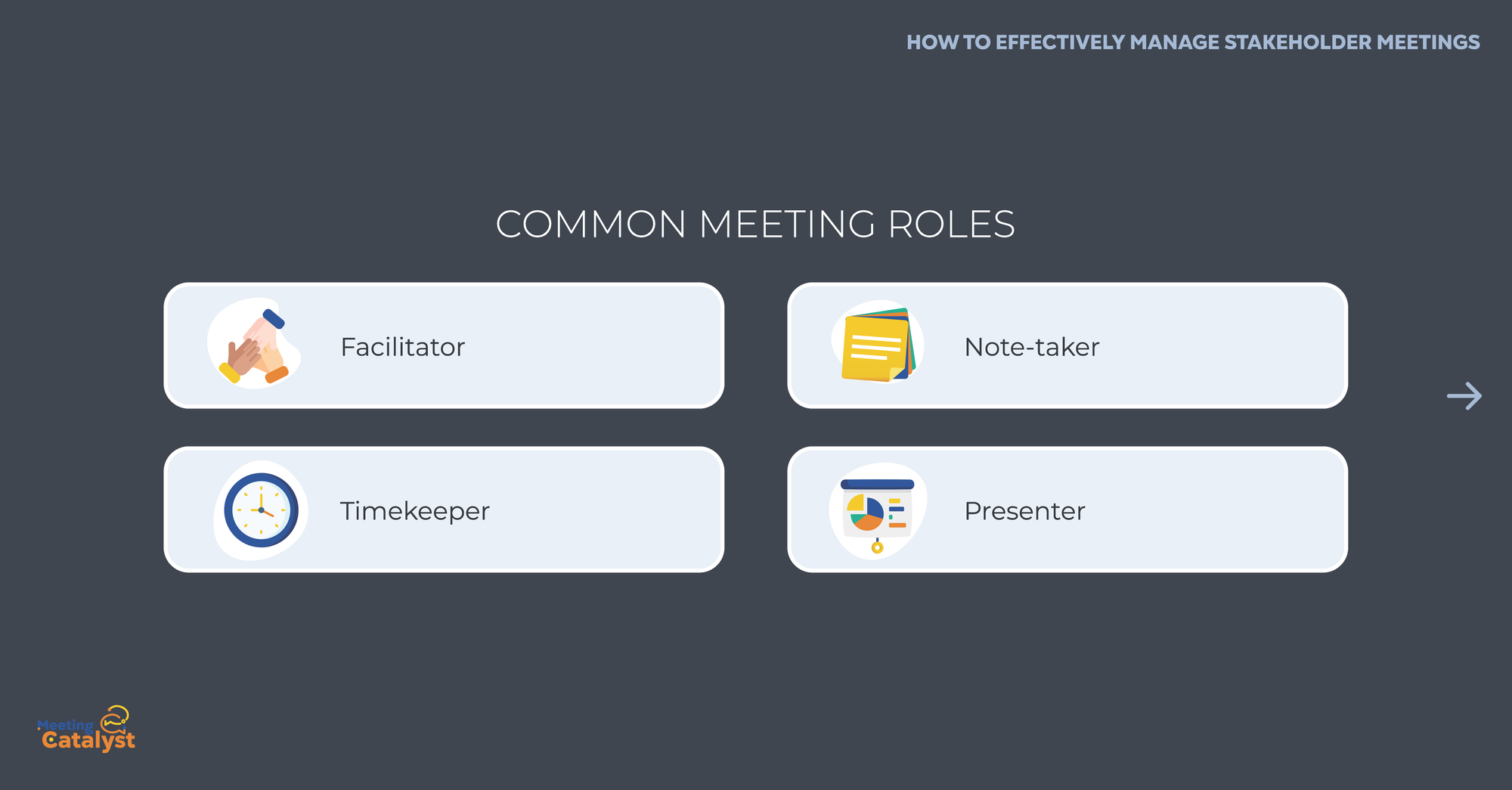
Some common meeting roles include:
- Facilitator: Guides the meeting, ensures adherence to the agenda, and encourages participation.
- Timekeeper: Monitors the time allocated for each agenda item and helps keep the meeting on track.
- Note-taker: Records key points, decisions, and action items for future reference.
- Presenter: Delivers presentations or provides updates on specific topics.
These roles help create a more organized and efficient meeting process, leading to better outcomes.
The Benefits of Rotating Meeting Roles
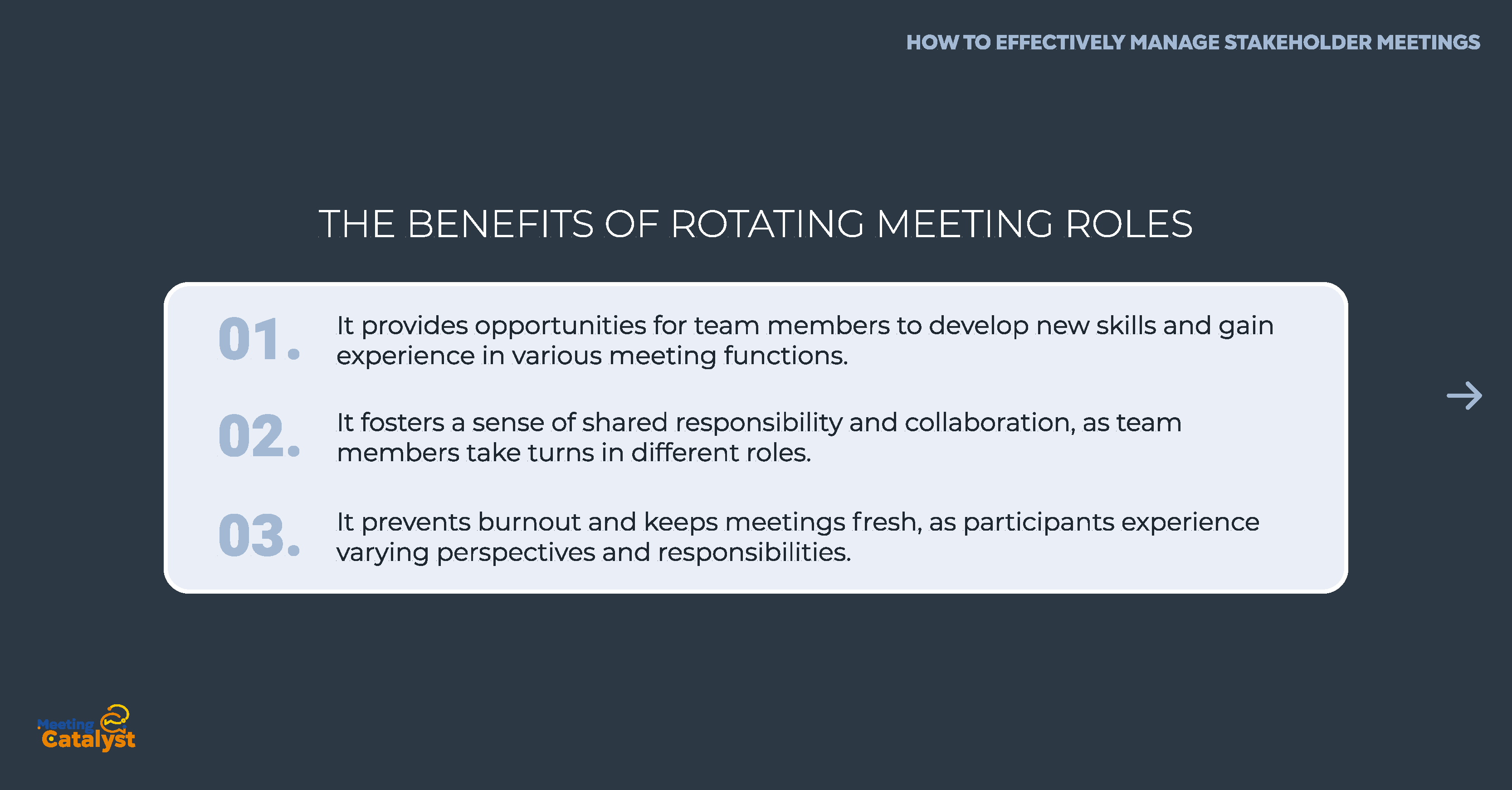
Rotating meeting roles can offer several advantages:
- It provides opportunities for team members to develop new skills and gain experience in various meeting functions.
- It fosters a sense of shared responsibility and collaboration, as team members take turns in different roles.
- It prevents burnout and keeps meetings fresh, as participants experience varying perspectives and responsibilities.
By rotating roles, you promote a culture of continuous learning, collaboration, and engagement within your team.
In conclusion, assigning participant roles is key to enhancing meeting engagement and fostering a culture of collaboration among team members. By incorporating this practice into your meeting design, you can maximize team collaboration and drive better meeting outcomes.
Implementing Time Management Techniques for Efficient Meetings
Effective time management is crucial for enhancing collaboration and ensuring meeting effectiveness. By managing time efficiently, participants can stay focused on the agenda, maintain high levels of engagement, and maximize the value of each meeting. In this section, we'll discuss the impact of time management on collaboration and meeting effectiveness, and explore strategies for effective time management in meetings, such as timeboxing agenda items, using timers or timekeeping tools, and encouraging concise and focused discussions.
The Impact of Time Management on Collaboration and Meeting Effectiveness
Efficient time management can lead to several benefits, including:
- Improved focus on the agenda and meeting objectives
- Enhanced participant engagement and satisfaction
- Better decision-making and problem-solving, as discussions remain focused and productive
By ensuring that meetings run smoothly and efficiently, you create an environment that fosters collaboration and drives optimal outcomes.
Strategies for Effective Time Management in Meetings
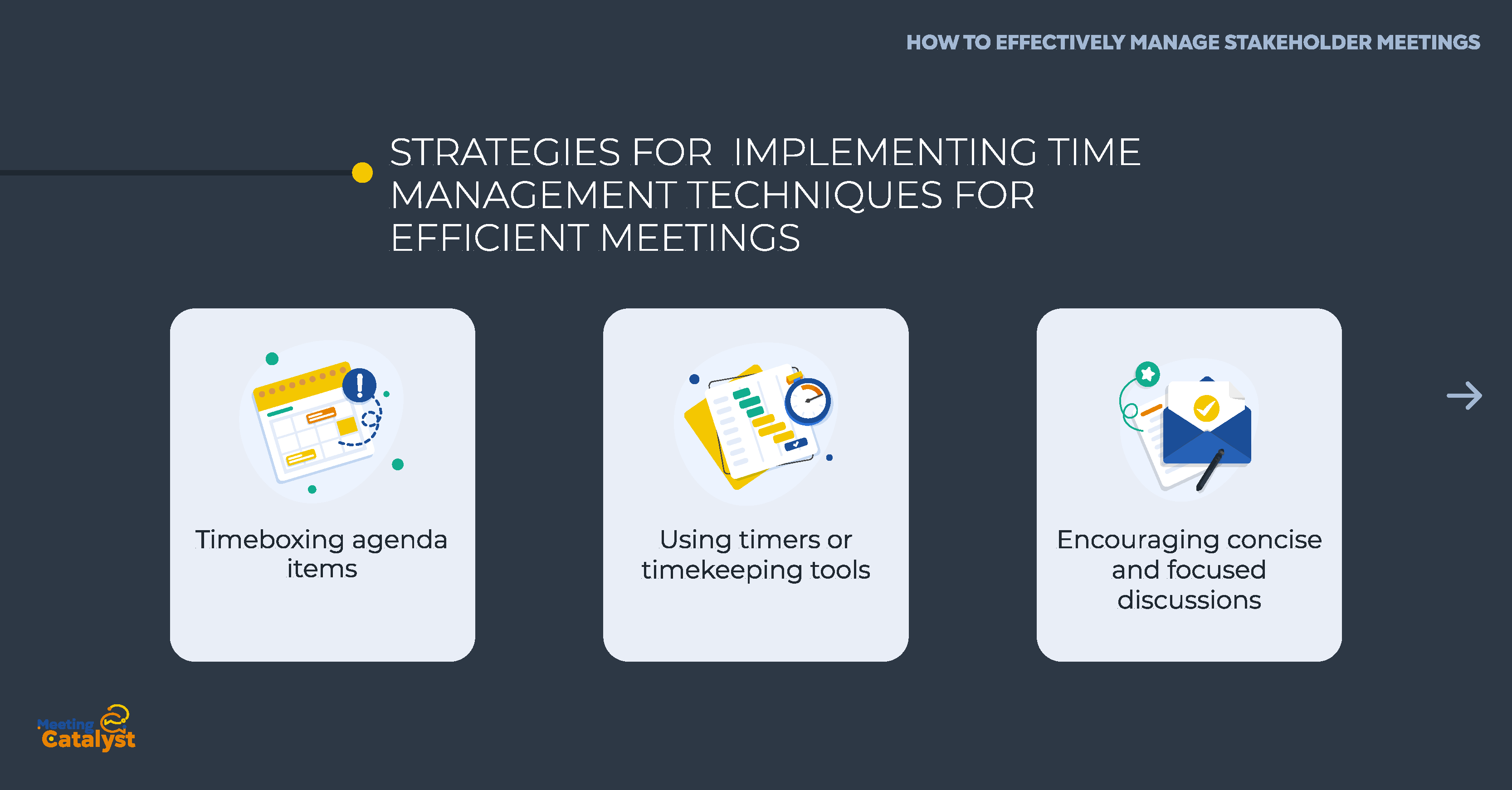
To improve time management in your meetings, consider implementing the following strategies:
- Timeboxing agenda items: Allocate a specific amount of time for each agenda item and stick to it. This helps maintain focus, prevents discussions from dragging on, and ensures that all topics are addressed.
- Using timers or timekeeping tools: Utilize a timer or timekeeping tool to monitor the time allocated for each agenda item. This can help participants stay on track and avoid getting caught up in lengthy, unproductive discussions.
- Encouraging concise and focused discussions: Set expectations for concise, relevant contributions from participants. Encourage team members to stay focused on the topic at hand and avoid going off on tangents.
By adopting these time management techniques, you can create more efficient meetings and enhance overall meeting effectiveness. Implementing these strategies will help your team stay focused on the agenda, maintain high levels of engagement, and maximize the value of each meeting.
Employing Engagement Strategies for Collaborative Meetings
Fostering engagement and team participation is essential for creating a productive and collaborative meeting environment. When participants are actively engaged, they are more likely to contribute valuable insights and ideas, leading to better decision-making and problem-solving. In this section, we'll discuss the significance of fostering engagement and participation in meetings and explore effective engagement strategies such as icebreakers, team-building activities, active listening, open dialogue, visual aids, interactive tools, and breakout sessions.
The Significance of Fostering Engagement and Participation in Meetings
An engaged and participatory team can lead to several benefits, including:
- Enhanced creativity and innovation
- Improved communication and understanding among team members
- Increased commitment to shared goals and objectives
- Higher levels of satisfaction and motivation
By promoting a culture of engagement and participation, you can maximize the potential of your team and ensure that every meeting yields meaningful results.
Effective Engagement Strategies for Meetings
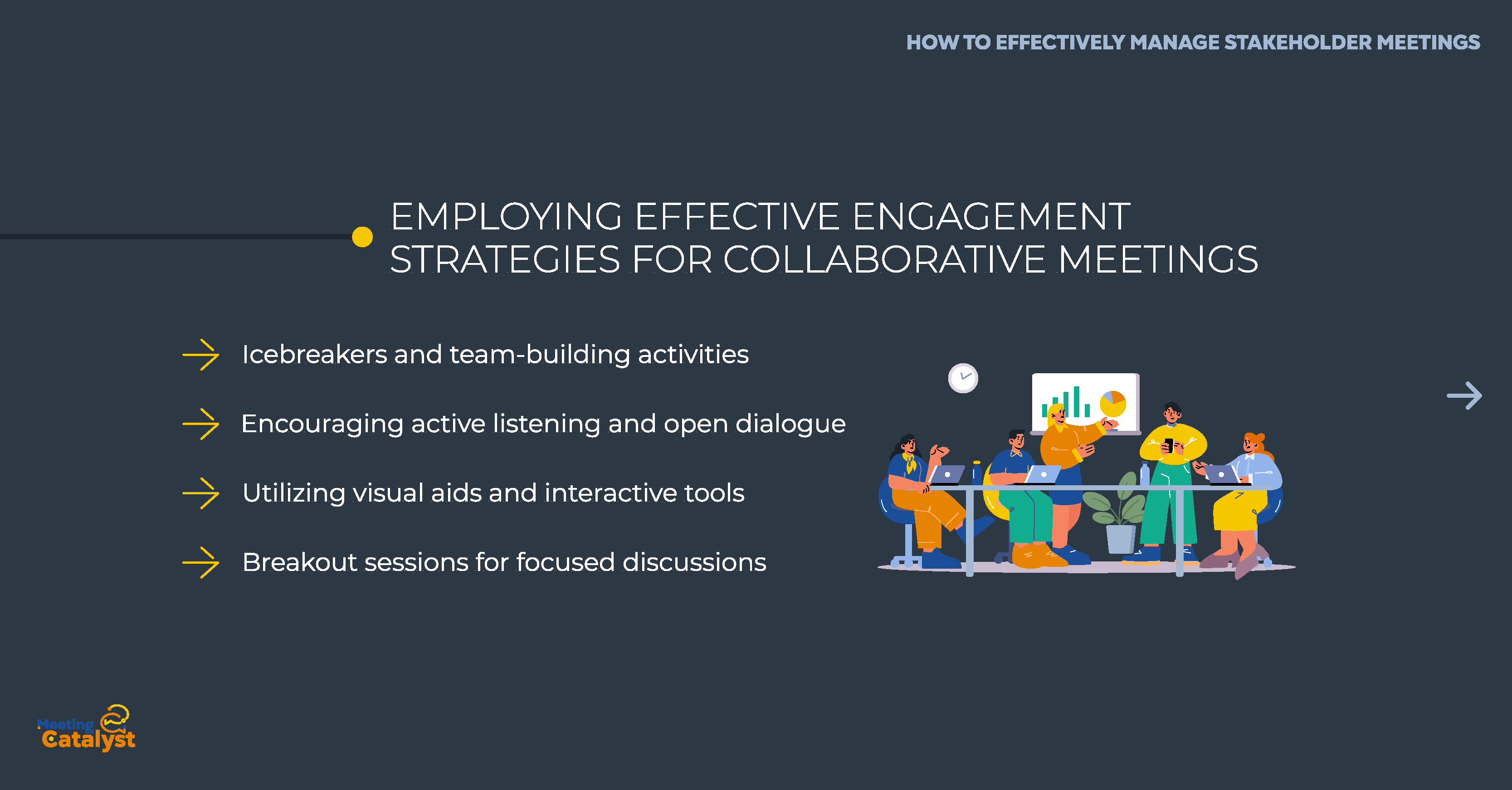
To encourage engagement and participation in your meetings, consider implementing the following strategies:
- Icebreakers and team-building activities: Start meetings with activities that help team members feel comfortable and connected. This can set a positive tone for the meeting and enhance collaboration.
- Encouraging active listening and open dialogue: Foster a culture where participants feel encouraged to listen attentively and share their thoughts without fear of judgment. Promote open and honest communication to build trust and rapport within the team.
- Utilizing visual aids and interactive tools: Incorporate visuals and interactive tools, such as slide presentations, whiteboards, or digital collaboration platforms, to keep participants engaged and facilitate the sharing of ideas.
- Breakout sessions for focused discussions: Divide participants into smaller groups to discuss specific topics or challenges. Breakout sessions can encourage more in-depth conversations and help ensure that everyone has a chance to contribute.
By employing these engagement strategies, you can create more collaborative meetings that foster team participation and drive better outcomes. Implementing these techniques will help your team stay engaged, share valuable insights, and work together to achieve shared goals.
Conclusion
In summary, effective meeting design plays a crucial role in maximizing collaboration and driving better outcomes for your team. By focusing on the key components we've discussed, you can create meetings that foster engagement, boost productivity, and promote teamwork. Remember to:
- Set clear objectives that align with your team's goals
- Craft a well-structured agenda to guide discussions and maintain focus
- Assign participant roles to enhance engagement and ownership
- Implement time management techniques to make the most of your meetings
- Employ engagement strategies to encourage active participation and open dialogue
Meeting planning and design is an ongoing process that requires regular evaluation and refinement. As your team evolves and your objectives change, be prepared to adjust your meeting design to continue fostering a collaborative environment that supports your team's growth and success. By prioritizing effective meeting design, you'll not only maximize collaboration but also create a more cohesive, motivated, and high-performing team.